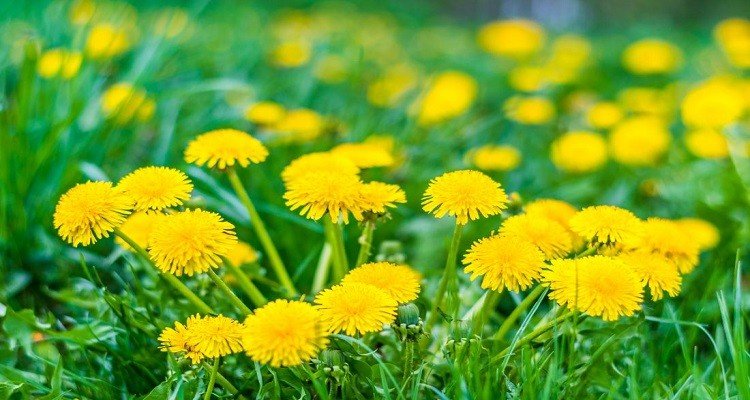Dandelion flower specifications
- Botanical Name : Taraxacum officinale
- Order : Asterales
- Family : Asteraceae
- Subfamily : Cichorioideae
- Tribe : Cichorieae
- Subtribe : Crepidinae
- Genus : Taraxacum
- Plant Type : Perennial
- Mature Size : 2–6 in. tall, 2–6 in. wide
- Sun Exposure : Full sun
- Soil Type : Well-drained
- Bloom Time : Spring
- Flower Color : Yellow
- Native Area : Europe, Asia
Dandelion flower : Contrary to popular assumption, dandelions are more than just a weed that takes over your front lawn. Native to Europe and Asia, dandelions have been used medicinally for thousands of years, and they’ve been a staple in certain cuisines for almost as long.
The greens of the plant are high in calcium, iron, and potassium, and very low in calories, making them delicious in salads. The flowers have many uses as well, including for wine, fresh in salads, and deep-fried in butter, and the young buds are high in protein. Unopened flower buds are tender and tasty, and they offer a crunch in green salads. Dandelion flower
Every part of the plant can be used and they’re easy to grow. Best planted in early spring through late summer, dandelions will grow quickly, with seeds germinating in around 10 days.
read more : Everything about yarrow flower : How to Plant & care for them

Selected species
- Taraxacum albidum, the white-flowered Japanese dandelion, a hybrid between T. coreanum and T. japonicum
- Taraxacum aphrogenes, the Paphos dandelion
- Taraxacum arcticum
- Taraxacum balticum
- Taraxacum brachyceras
- Taraxacum brevicorniculatum
- Taraxacum californicum, the California dandelion, an endangered species
- Taraxacum centrasiaticum, the Xinjiang dandelion
- Taraxacum ceratophorum, the horned dandelion
- Taraxacum coreanum
- Taraxacum desertorum
- Taraxacum erythrospermum, the red-seeded dandelion
- Taraxacum farinosum, the Turkish dandelion
- Taraxacum holmboei, the Troödos dandelion
- Taraxacum hybernum
- Taraxacum japonicum, the Japanese dandelion, no ring of smallish, downward-turned leaves under the flower head
- Taraxacum kok-saghyz, the Kazakh dandelion
- Taraxacum laevigatum, the rock dandelion, achenes reddish brown and leaves deeply cut throughout the length, inner bracts’ tips are hooded
- Taraxacum lissocarpum
- Taraxacum minimum
- Taraxacum mirabile
- Taraxacum officinale ( syn. T. officinale subsp. vulgare ), the common dandelion, found in many forms
- Taraxacum pankhurstianum, the St. Kilda dandelion
- Taraxacum platycarpum, the Korean dandelion
- Taraxacum pseudoroseum
- Taraxacum suecicum
read more : Everything about chamomile : How to Plant & care for them
Dandelion flower Care
Most people know dandelions grow readily, though very few have tried to intentionally grow and care for them. Caring for the flowers is fairly easy. They will grow in a variety of favorable (and unfavorable) conditions, making them a sure-fire crop for novice and experienced gardeners alike
Dandelions can be added to your herb garden, or grown in a row in your vegetable garden. They can also be directly sown into containers for the ability to harvest closer to the kitchen.
Dandelions are generally problem-free, for better or for worse. They’ll grow without any problems whatsoever and are resistant to many pests and diseases that may afflict other summer flowers or crops in your landscape.
-
Light
Dandelion plants prefer a spot in full sunlight, but can happily grow in just about any light conditions. That being said, they will grow more rapidly under at least eight to 10 hours of sunlight daily.
-
Soil
If there’s one thing dandelions aren’t particular about, it’s their soil mixture. Whether your garden boasts soil that is sandy, loamy, rich, or clay-like, dandelions will find a way to thrive. However, if you’re hoping to grow plants that are nutritious and hearty, you’ll want a mixture that is rich in nitrogen.
-
Water
Dandelion plants like consistent moisture and should be watered regularly in order to keep the soil moist but not sopping. If you’re unsure whether your plants need water, stick your finger 2 to 3 inches deep into the soil — if it’s dry, it’s time to water your plant.
-
Temperature and Humidity
Dandelions can tolerate soil temperatures down to 50 degrees Fahrenheit but thrive best in a climate that’s around 70 degrees Fahrenheit or more. This explains why they often don’t start cropping up in your lawn as ” weeds ” until mid-summer or so.
Additionally, dandelions require no special humidity and can thrive in both humid and moderately dry environments.
-
Fertilizer
Dandelions can benefit from a bit of organic matter mixed into the soil, but otherwise do not need any specific fertilizer, though it will not be detrimental to their growth if they happen to receive some from nearby applications to other plants. That being said, if you plan to eat and cook with your dandelion plants, you need to make sure to only apply an organic fertilizer to any nearby crops to prevent any chemical contamination. Dandelion flower
read more : Everything about marigold flower : How to Plant & care for them
Iran dried dandelion flower
Export of dried dandelion flowers is one of the most important native medicinal plants in Iran, the export of which requires a comprehensive and correct plan for marketing in international markets.
One of the most valuable medicinal plants is dandelion , which is grown in Iran as a wild flower and can even be cultivated. Unfortunately, due to the lack of attention to the processing sector of medicinal plants, many domestic products and wild plants are exported from the country unprocessed.
This lack of investment in the conversion industry sector has benefited markets and export target countries, as they re-sell their products to Iran at a much higher price.
In addition to its decorative aspect, dried dandelion flower has many usages in traditional medicine and pharmacy. The reasonable price of dried dandelion flowers has caused the sale and purchase of dried dandelion flowers for export to bring great profits to the exporters and wholesalers of dried dandelion flower , and in this way, it will also help the country’s economy and currency.
read more : Drying natural flowers | Introducing 8 wonderful ways to dry flowers
How to Grow Dandelions From Seed
Dandelions can be sown outdoors four to six weeks before the last spring frost. Sow seed directly into the ground — once they’ve sprouted above the soil, thin them so they’re 6 to 8 inches apart. Dandelions readily reseed themselves, but often in places where you’d rather they didn’t grow. Be sure to clear them from your garden before they bolt to seed if you’d like to avoid this issue.
How to Harvest Dandelions
A few weeks before harvesting your dandelion’s leaves, cover the plants with dark, opaque fabric to block out most of the light—this will blanch the leaves, reducing the plant’s bitterness. The youngest leaves are the least bitter and most flavorful, and tender leaves can be picked throughout the growing season.
If you are harvesting the blossoms from your dandelions, pick the flowers when they are still bright yellow and young. Use them fresh, making sure to remove all of the stems. To prevent the flowers from closing after cutting, place them in a bowl of cold water, taking them out just before eating or serving them. The roots of the dandelion can be harvested at any time.
Notice : this article has been translated by google translate , if you have any questions or need more information Please contact us by writing a comment on this page.



0 Comments